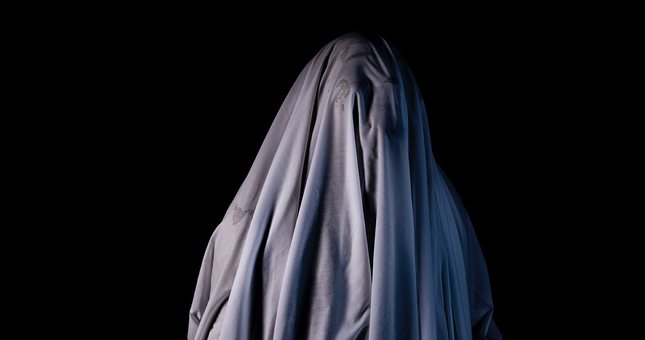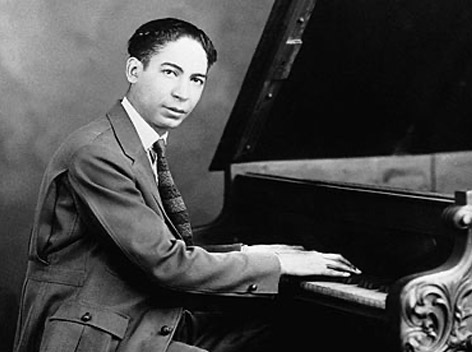
Narratives of Disembodiment: How Ghost Stories Teach Us About Trauma
The Revelatory Ghosts of Hamlet, Beloved, and The Haunting of Hill House
One dreary, wet British afternoon, I was waiting to cross a busy intersection in front of the University of Newcastle-upon-Tyne. I looked across both lanes of traffic and saw him clear as day, waiting to cross the street from the other side. The ghost of Hamlet’s father had a surprisingly solid body, and he brushed past me quickly, on his way to tea or another rehearsal. It was jarring. The afternoon before, I had seen this actor in the Royal Shakespeare Company’s production of Hamlet, one of the bard’s plays that I was also teaching that term. As much as I knew that this was an actor, a human being out of costume merely doing the stuff of daily life, I was strangely spooked.
As a child, I enjoyed ghost stories—but in my teenage years, I resisted reading or watching most anything in the horror category. As C.S. Lewis explains in the preface to The Screwtape Letters, there are two unhealthy ways to deal with the existence of devils: “One is to disbelieve in their existence. The other is to believe, and to feel an excessive and unhealthy interest in them.”[i] I still heed Lewis’s words and veer away from a good deal of horror (particularly occult) content. In grad school, though, I began thinking about the more metaphorical significance of ghosts in fiction and film soon after I saw the embodied “ghost” of Hamlet’s father walking past me on the crosswalk.
In Act I of the play, the ghost of the Prince’s recently deceased father first tells his son to, “Mark me,” asking Prince Hamlet to attend to an unacknowledged trauma. King Hamlet’s ghost then shares “the secrets of my prison-house,” including the horrifying truth that his recent death was actually a murder, committed by the hand of his own brother, who is now King.[ii] As he describes the manner in which poison was poured into his ear, the truth of his trauma poisons Hamlet’s psyche, haunting him for the rest of the play. Hamlet repeatedly tries to kill his uncle and avenge his father, but these unfulfilled repetitions leave him so angry and unsatisfied that he eventually loses his grip on reality and begins to terrorize those around him. In this sense, Hamlet is not just a revenge tragedy but also a story about the impact of intergenerational trauma.
The Body as a Battlefield in Toni Morrison’s Beloved
This same theme is central to Toni Morrison’s Pulitzer Prize winning novel Beloved, which I studied in graduate school not long after encountering the ghost of Hamlet’s father. This contemporary masterpiece is a poignant examination of inherited trauma, passed down from the first slave ships to cross the Atlantic to an escaped slave’s family in 1850. Morrison derives the central plot in her story from a historical newspaper fragment about the imprisoning of Margaret Garner, an escaped slave that chose to commit infanticide rather than allow her baby daughter to be taken back into slavery. The novel opens with the puzzling words “124 was spiteful. Full of baby’s venom,” and only after reading a few more lines, do we realize that Beloved is actually a ghost story and that house number 124 is a haunted house.[iii] At first, this turned me off to the story; I wanted traditional realism rather than magical realism. But Morrison’s rich, yet tragic, poetic prose ushered me in, and it was hard to resist, in spite of suspicions about this kind of tale.
In a ghost story such as Beloved, the ghosts are less supernatural phenomena than a manifestation of the disembodiment that occurs when a human being is subjected to life-altering trauma. In his best-selling book, The Body Keeps the Score, Bessel Van Der Kolk explains that the essence of trauma is “dissociation”—when the mind cannot process what is happening to the body, so the body and unconscious mind absorb the traumatic impact, often repeating it via dreams, bodily tics, or compulsions. The “overwhelming experience” of one who has undergone trauma is “split off and fragmented, so that emotions, sounds, images, thoughts, and physical sensations related to the trauma take on a life of their own.”[iv]
Dissociation reconfigures the body as a “crime scene” or “battlefield.” We see this often in fiction from the Renaissance to the present.[v] In Shakespeare’s Othello, after the tragic general has killed his wife, he is asked directly who committed the murder and states, “That’s he that was Othello. Here I am.”[vi]
We also see the split self in the popular contemporary novel Fight Club by Chuck Palahniuk. The central, unnamed character literally splits into two personalities, a result of the unresolved trauma of the perceived death of God. The protagonist, who becomes Tyler Durden after the dissociation occurs, tries to reconnect to his body by inviting violence against himself in a self-formed “fight club.”[vii]
Morrison’s Beloved is a powerful fictional example of the way that, the “emotions, sounds, images, thoughts, and physical sensations related to the trauma take on a life of their own”.[viii] As the novel opens, the reader is immediately thrown into the present day emotional and spiritual chaos of house number 124 and its inhabitants: mother Sethe (Garner’s fictional counterpart), daughter Denver, and the ghost of the slain child that we are told is not “evil but sad.”[ix] Sethe’s mother in law, Baby Suggs, tells us “Not a house in the country ain’t packed to its rafters with some dead negroe’s grief.”[x] The commonality of the haunting is representative of the memorialized diaspora, as well as the enduring demons that haunt the survivors.
As the narrative proceeds, the reader must work hard to piece together Sethe’s fragmented interior world. The narrative is non-linear, full of flashbacks, which Sethe refers to as “rememories;” these are so real that the characters could bump into one on the street.[xi] These “rememories” are also ghosts—and they don’t only belong to Sethe.
In her book on Trauma Fiction, Anne Whitehead explains that “novelists have frequently found that the impact of trauma can only adequately be represented by mimicking its forms and symptoms, so that temporality and chronology collapse, and narratives are characterized by repetition and indirection.”[xii] When reading Beloved, we become immersed in characters’ fragmentation, sensing the lost time, and consistently trying to understand the story that must be re-narrated in order for the ghosts to be exorcised.
In the novel’s most confusing sequence, Morrison breaks from any sort of linearity, allowing us to hear the voices of some of the nameless Africans, human beings made in God’s image yet lost to history. Their lives were either marred or completely taken on the Middle Passage. As they cry out, their voices are one and the same as the ghost of Beloved, and the living Denver and Sethe. Identities merge and split, and we recognize the intergenerational fragmentation, the haunting that leads to dissociation as a means of self-protection.
The ghost metaphor is apt when speaking about slavery. The construction of race for the sake of increasing white power required a split between the African’s body and their mind/soul. For the most part, slaves were thought of as only bodies, and these bodies were commodities, not owned by the same person who possessed the mind/soul that matched that body.
The mind of an African was a threat to the slaveholder, so it was intentionally kept malnourished, unable to read or write. In Soul on Ice, Eldridge Cleaver explains that this body/mind split continued into the twentieth century. African Americans could “safely” become entertainers or athletes, adored by white fans, but that when they exercised their minds, becoming professors, doctors, and lawyers, they were seen as a threat.[xiii]
We also see critiques of sinister attempts to split the mind and body at work in 21st century fictional narratives such as Jordan Peele’s satirical horror film, Get Out. In this story, black Americans are put under spells by “nice” white Americans in only to have their minds stolen from their bodies, replacing them with subservient, robotic ciphers.[xiv] As they are possessed by a spirit of enslavement, and their minds are forever separated from their bodies, we are reminded of the often subtle perpetuation of these damaging ideologies and practices even in the present day.
In a moving passage from Beloved, we are introduced to a group of African Americans who are, like the protagonists of Peele’s film, facing the tragic separation of mind and body.
Morrison takes us to a secret worship service deep in the Ohio woods, attended by recently freed or escaped African Americans. The elderly pastor, known as Baby Suggs Holy, asks the congregants to dance with abandon, clasping and naming the body parts that they love, that now belong to them rather than to their masters. She then exclaims, “ In this here place we flesh; flesh that weeps, laughs…Love it. Love it hard.”[xv]Although this powerful service of attempted body/mind reintegration is transformative in the moment, its impact is soon lost. The ghosts are not fully exorcised, and Sethe, in particular, is left to confront the internalized narrative that she is only a body, and that her body is that of an animal.
Sethe’s deep shame is unearned. As trauma therapist and former L’Abri worker Heather Dryden explains, “It is a shameless act to violate boundaries” and the perpetrator who violates the boundaries of another “injects shame into the victim,” so much so that “what is done to you becomes you.”[xvi] This is when disassociation occurs, as the victim is unable to fully face and process their trauma.
Intergenerational Ghosts in The Haunting of Hill House
Human shame and fear are also the core impulses of the haunting in Netflix’s popular series The Haunting of Hill House, a complex narrative that focuses on sadness, grief, and trauma more than sensationalized horror. The story, about a family haunted by a hidden, unspeakable dark intergenerational secret, is a primer on the way that the ghosts of secrets, guilt, and shame are repressed in order for each family member to function. Only by not inhabiting the body, the scene of the crime, can one attempt to be “sane.” Throughout the series, we constantly ask ourselves if the menacing, seemingly prophetic ghosts are supernatural beings or metaphorical representations of dissociation resulting from trauma. I believe that they are both.
The first episode opens with a voiceover that points to a “loss of sanity” experienced by the Crain family members in an effort to protect themselves: “No live organisms can continue to exist sanely under conditions of absolute reality.”[xvii] The family, including Olivia and Hugh and their five children, move into an abandoned mansion, previously owned by the Hill family, in order to flip it in a manner of months. Olivia is initially the most affected by the seductive darkness of the house. She struggles with migraine headaches, dreams, and hallucinations. At first she fears the “ghosts” she encounters, but she soon succumbs to their violent suggestions in order to “protect” her own children, to keep them from going out into a “dark world” which has “teeth” that will eat them.
According to Heather Dryden, there are four initial responses to fear and danger: fight, flight, freeze, or fawn.[xviii] We see Olivia embody all four responses, until she is so consumed by the false reality of the ghosts that plague her that she “safely” stays in the fawning state, internalizing all of their suggestions. Olivia states multiple times that the house itself is like a body, containing both bones and meandering spirits; she even remarks, at one point, that the house is “schizophrenic.” At this point, she has dissociated from her own body, not understanding that the ghosts she experiences are disembodied fragments of her own unconscious traumatic memories.
Her husband, Hugh, is a man with goals; he wants to “fix” everything, including his wife. While his first project is flipping the house, the house is not willing. There is a locked “red room” in the center of the house that no one can enter, and this room, we eventually learn, has been flooded with water that infests the rest of the home with mold. Hugh originally believes that the mold is a result of a violent storm that happened days before, but no matter how much he cleans and even replaces walls, the mold keeps seeping out from the “heart” of the house. Like Olivia, Hugh wants to protect his family from trauma, but his inactions, like Olivia’s actions, actually lead to more ghosts of secrecy, guilt, shame, despair. The family’s oldest child, Steve, explains that “I have lived with ghosts since I was a kid—before I even knew they were there. Ghosts are guilt, ghosts are secrets, ghosts are regrets, ghosts are failings.”
When Olivia commits a dreadful act and then tragically dies herself, Hugh closes the vault of information, locking the door to protect his children “from the monsters on the other side.” He does this out of love, but these ghosts are not exposed and exorcised (until the end), and this leads to the children’s resentment of their father and his lifelong alienation from them.
Theodora, the family’s middle child, is so deeply sensitive to the presence of ghosts and the reality of trauma that she eventually becomes a child therapist. In one poignant scene, she is working with a foster child who is drawing pictures of a scary ghost called “Mr. Smiley.” Theo tells the child: “You’re a lot like me. I was afraid. I imagined myself behind a big wall that was all around me, a big wall all made of bricks. We’re great builders. We make ourselves really safe, and no one ever gets in.” She soon recognizes that the child has been so traumatized by abuse that she “created a monster to compartmentalize and cope” because her abuser was someone that was supposed to love and care for her.
The Crain children most impacted by the ghosts are the twins, six-year old Luke and Nell. Both of them are harassed by ghosts that embody the future horror of their adult lives. Nell continually sees a “bent neck lady” that is actually a vision of her own death, and Luke asks his mother “What if I’m so sad and afraid in the dark that I put poison in me and poison myself for years and years and my body breaks down?” Luke’s shame and fear coerce him into turning to heroin addiction to protect himself from recognizing the truth, reminiscent of the descriptions of “God-hungry” homeless addicts in Dr. Gabor Mate’s In the Realm of Hungry Ghosts.[xix]
Similar to Morrison’s Beloved, the narrative of trauma in Hill House is non-linear, fragmented, with large gaps of missed time. Nell explains that: “Time is out of order. I thought for so long that time is like a line, that our moments are laid out like dominoes. They fall into one another… But I was wrong. It’s not like that at all. The moments fall around us like rain….” In this sense, the reappearing ghosts are the future, present, and past.
The non-linear nature of the storytelling is not the only disorienting feature that represents the existential experience of trauma. Like the characters themselves, the viewer also loses grasp of what is “real” and what is “imaginary.” In the series, the twins’ parents try to explain their visions as mere dreams that “spill over” into their waking hours. Luke, in particular, feels betrayed and invalidated because no one ever believes him. When he tells his father “this house is bad, dad. It’s bad,” his father dismisses his concerns by saying “Big boys know the difference between what is real and what is imaginary.”
In the last episode of the series, the adult children find themselves back in the “red room” of the house that they all left over twenty years ago. In this space, each of them has a harrowing vision of the things that causes them the most shame.
For instance, Steve has exploited his family and destroyed his marriage by turning their stories of trauma into a best-selling book. In the vision, his ex-wife tells him that he is not “flesh and blood” but a “plastic parasite” that feeds off of others for his own gain.
Shirley, the oldest daughter, a lifelong perfectionist and rule follower—sometimes a surrogate mother to her siblings—admits to herself that she is a hypocrite who hides her own dark secrets, including a brief affair, while chastising others.
Theo, Luke, and Nell are all damaged by the walls that they have built around themselves, preventing healthy relationships and courting addictions of different types. Their deep fear and shame are reminiscent of the first negative emotions felt by human beings. When Adam and Eve violated the boundaries that the Lord set for them, they immediately felt a need to hide their bodies, leading to an initial splitting of the original design of mind/soul and body connection. And in this climactic scene from The Haunting of Hill House, we can trace the ways in which shame and fear can lead to mental/physical disconnect that is damaging and destructive.
Although both Beloved and The Haunting of Hill House are ultimately trauma narratives, they both end with a glimmer of hope. In each story, the verbal, linear re-narrating of trauma, told to a listener that can hold the story, helps to move the characters towards reintegration. Only when one knows that they are loveable, says Heather Dryden, can one impacted by trauma begin to heal.[xx] In the last chapter of Beloved, Sethe finally sees herself as loveable after her lifelong friend and current lover says that he “wants to put his story next to hers.”[xxi] Together, they re-narrate what has been lost. Similarly, the ending of Hill House shows that re-narration of truth leads to a deeper reality that brings the estranged family back together.
These stories, although painful, can help grow the readers’ and viewers’ empathy if we are brave enough to enter the often violent, disorienting narratives. Dryden points out that the underlying trauma of all of humanity is a divorce of intimacy with a Creator that then leads to human relational dysfunction, violence, and shame.[xxii] Both narratives highlight the ways in which cruelty and abuse can separate the mind from the body, turning us into “ghosts” without a center. Although both stories end with seeds of hope based on love and acceptance, they do not grapple with the deepest sense of spiritual alienation, our defining human trauma. Only after knowing we are truly loved by God, thus loveable, can we begin to feel whole again.
The prevalence of Ghost Stories isn't the only social phenomenon having to do with disembodiment. Read Jens Zimmermann's Abandoning Earth: Personhood and the Techno-Fiction of Transhumanism (coming April 14).
[i] C.S. Lewis, The Screwtape Letters (New York: Harper Collins, 1959), ix.



